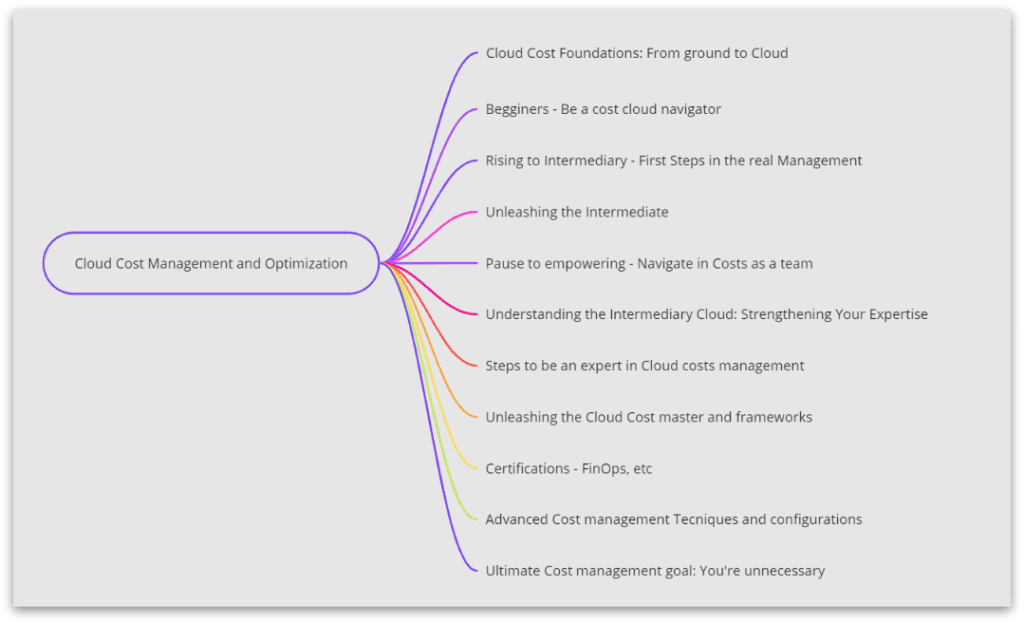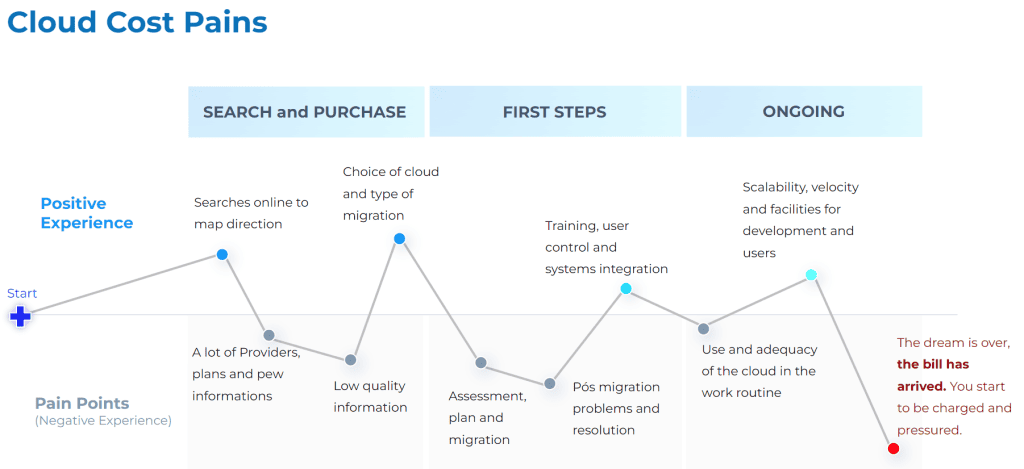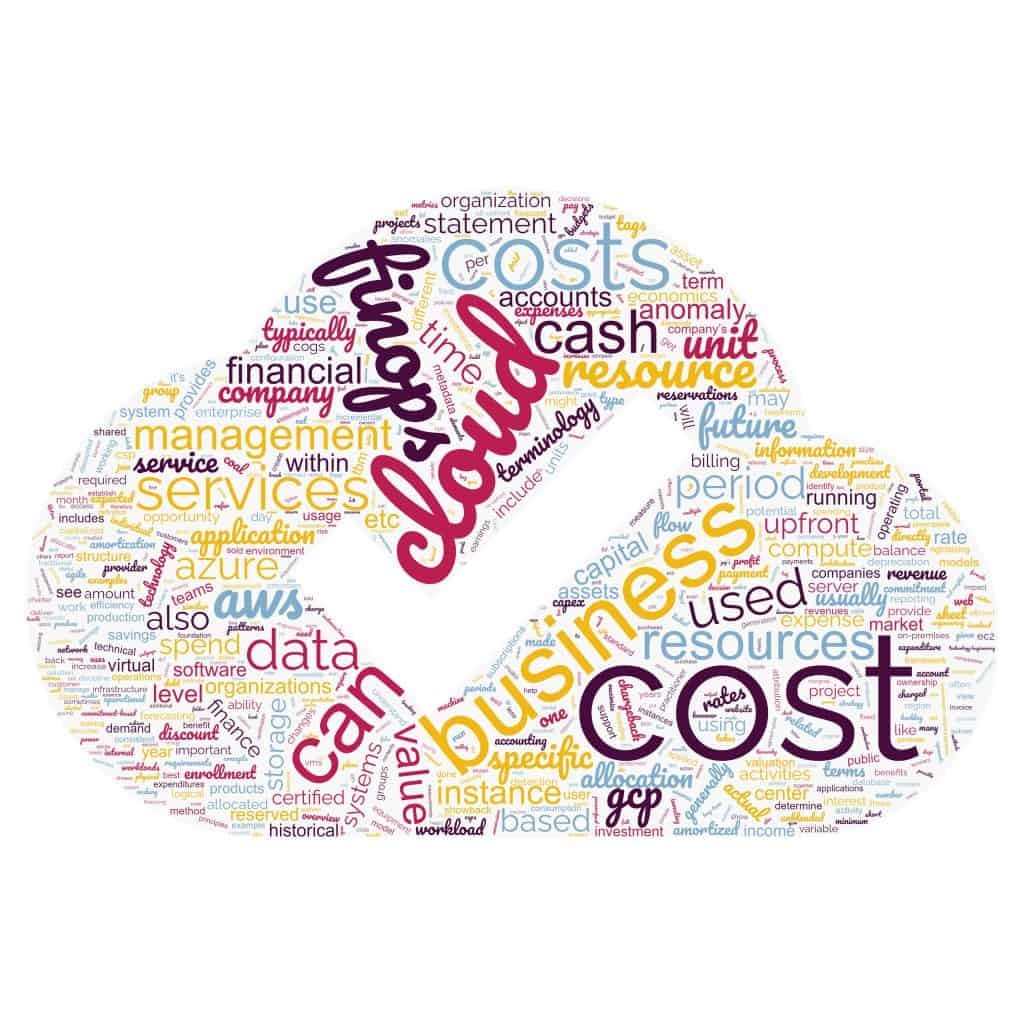In the era of scalable growth, high performance, and agile development, embracing the Cloud has become indispensable. Nobody told me – and I bet neither for you – that this migration comes at a “shadow cost,” a high price: the need for continuous learning. With auto-scaling, value discounts, resource monitoring, reserved instances, and various configurations and services at our fingertips, the Cloud presents new terms and intricate concepts.
In this ocean of new information – or cloudy sky – new terms and concepts, intricate details, complex business models, and services full of between-the-lines and asterisks, professionals face an uphill battle to monitor, manage and apply the best practices of Cost Governance and optimization in the Cloud.

The essential, scarce, and costly weapon these days is the only one that can help in this process: Applicable knowledge. And we are here to help you and Introduce the principal concepts of Cloud cost management because this is the only way to optimize your cloud and your costs.
This blog series will explore cloud cost management learning and the practical applications, configurations, and techniques, step-by-step. From understanding the fundamental concepts to mastering technical intricacies, we will delve into the challenges individuals, processes, and teams face. We will start with the basics:
In this comprehensive guide based on a trail on cloud cost management, we present a series of articles that cover different levels of knowledge and themes. From foundational concepts to beginner, intermediary, and expert levels, we provide valuable insights and strategies to help you effectively manage costs in the cloud.
- Foundations– Explore essential terms, concepts, and financial processes to kickstart your journey toward improving cloud costs. Start here and if it is too basic, go to the following article on Cloud Cost Foundations: From Ground to Cloud and discover more.
- Beginners: Learn how to effectively monitor costs, implement basic optimizations, and configure cost management at all levels. Check out our articles: Advancing from Beginners: Becoming a Cost Cloud Navigator and Preparing for the Intermediary Level: Rising to Real Management. Also, don’t miss our special article: Empowering Cost Navigation as a Team.
- Intermediary: Analyze and propose suitable strategies, and resource management plans, tackle complex configurations, and discover tools and best frameworks. Enhance your expertise with articles such as Understanding the Intermediary Cloud: Strengthening Your Skills, Steps to Becoming an Expert in Cloud Cost Management, and Unleashing the Cloud Cost Master and Frameworks. Additionally, explore our special article on Certifications in FinOps and more.
- Expert: Apply advanced frameworks, enforce cost governance and policies, utilize scripts and advanced configurations, and implement continuous monitoring and reviews. Learn cutting-edge techniques and configurations with our articles on Advanced Cost Management Techniques and Configurations. Finally, discover the ultimate goal of cost management in our article: You’re Unnecessary – Achieving the Ultimate Cost Management.
For best Understanding:

In this guide, we have introduced you to the levels of knowledge in cloud cost management and provided an overview of the articles that will help you navigate this complex field. Now, it’s time to dive into the details and equip yourself with the tools and knowledge you need to optimize costs and achieve financial efficiency in the cloud. Let’s explore each level step by step, uncovering key insights, best practices, and practical tips along the way. Get ready to embark on this journey toward cost optimization in the cloud!
Wondering if you need to read everything? We put the links to facilitate the navigation, but we strongly suggest reading to understand why, how, and when you must improve. Everything is linked; you must do or check the steps, following the configurations and techniques to arrive at a real optimization and Cloud Cost management. Your story probably started like mine: a romance with the cloud-based on promises of reducing on-premises costs and improving development delivery speed, all integrated and under control. But we know that costs are tripled as planned a few months later.

We will delve into the world of cloud billing and explore why it is necessary to gain insights into the billing structure, understand financial processes, grasp fundamental concepts, and identify specific business requirements. By familiarizing ourselves with these aspects, we can confidently navigate the cloud billing landscape, make informed decisions, and strategically align our financial objectives with the capabilities of the cloud. And optimize costs, of course.
Foundations: What is cloud cost management?
We will start by answering the fundamental question: Imagine you’re a chef running a bustling restaurant. You have various ingredients in your kitchen, each with a cost. You must manage your expenses carefully to ensure your business runs smoothly and profitably. This involves understanding the prices of ingredients, tracking inventory, and optimizing your recipes to minimize waste and maximize profits. In essence, cloud cost management is like being the chef of a cloud kitchen. Instead of ingredients, you’re dealing with cloud resources and services, each with its costs. Cloud cost management effectively monitors, controls, and optimizes these costs, ensuring that your organization uses cloud resources efficiently and stays within budget. Just like a chef creates delicious dishes while keeping costs in check, cloud cost management enables you to leverage the power of the cloud while maintaining financial control and achieving optimal cost efficiency.
Cloud cost management involves the processes and strategies implemented to effectively visualize, control and optimize the costs associated with cloud services. It encompasses several key aspects, and the first one is understanding the answer to another question:
Foundations: How is the billing done?
Imagine you’re at a self-serve buffet restaurant. Instead of paying a fixed price for your meal, you only pay for the items you select from the buffet. Each dish has a different price tag based on its ingredients and complexity. The more items you choose, the higher your bill will be. Cloud billing works similarly. Instead of a physical buffet, you have a menu of cloud services and resources available to everyone. Each service or resource has its own pricing structure, which can vary based on factors like usage, storage, data transfer, and processing power. When you use these cloud services, you accumulate costs based on the resources you consume and the duration of their usage. Just like selecting items from a buffet affects your final bill, the cloud services and resources you choose and the duration of their usage impact your cloud bill. Understanding cloud billing involves familiarizing yourself with the different pricing models, monitoring your usage, and optimizing resource allocation to ensure cost-effectiveness and avoid surprises when the bill arrives. In the next articles, we will discuss this aspect in detail.
And why…
Foundations: Why is this important?
We need a referential point for This answer- how everything works in our reality.
Imagine you’re a builder constructing a house. You have a budget and a set of materials at your disposal. You must carefully manage your resources to stay within budget and deliver a high-quality house. Similarly, you can access many powerful tools and services as a developer or technical professional working with the cloud. Understanding cloud billing and cost management is crucial because it allows you to optimize your resource usage, control expenses, and avoid unexpected costs. By monitoring your cloud usage and making informed decisions about resource allocation, you can ensure that your projects stay within budget and align with the financial goals of your organization.
Furthermore, optimizing costs contributes to your team’s and company’s efficiency, freeing up resources for other essential initiatives. Ultimately, having a good grasp of cloud billing and cost management empowers you to make informed choices, maximize the value of your cloud investments, and be a more effective and responsible contributor to your organization’s success. But the remaining question is: Why me?
Foundations: Why me?
When you migrate to the cloud, your development process change. And to ensure flexibility and agility, the insertion of new services and resources is responsible for developers and IT itself. Thus, projects do not stop in an approval queue or financial analysis processes. The result of this: unmonitored costs, unshared resources, lack of control, need for architecture revisions, and unowned projects, among other problems. Therefore, this new responsibility ends up being inserted into the development routine.
While it offers incredible flexibility and facilities, it’s important to understand that using cloud resources comes with costs. Cloud cost management involves monitoring and optimizing these expenses to ensure you use your resources most efficiently.
As a technical person, understanding cloud cost management is essential for several reasons. First and foremost, it helps you and your team stay within budget. You can make informed decisions about resource allocation and usage by knowing the costs associated with cloud services and resources. This ensures that you’re not overspending or wasting resources unnecessarily. So, do you wanna know where and how to start?
Foundations: Where and how to start?
Where, hope here. It is recommended to start with your level of knowledge: if you already understand the cloud, you will need to understand its plans and promotions. If you already understand the basics of cloud cost management, you will need to understand the basics of enterprise financial flows. To make all of this work together, you’ll need to bring the teams involved together and apply improvements and optimizations, among other points explained below. The study is fundamental, and the applicability of this knowledge is the focus.
How? You have to read the next explanation and apply tips and configurations.
About Foundations to Expert: Sum up the next steps in the articles:
1. Understand the Foundations: Begin by familiarizing yourself with the basic concepts and terminology related to cloud cost management. You can begin here, keep reading the next articles, use your tools and books, or search by certifications. In this area, the more recognized certifications by the employees FinOps, Certified Cloud Cost Professional (CCCP), AWS Certified Cloud Financial Management (CFM), Azure Cost Management and Billing, and Google Cloud Certified.
2. Identify your disponibility and align with your company: Gain a solid understanding of cloud cost management concepts, notwithstanding if you don’t want to be a cloud cost specialist. That’s part of you, but if you want to help your company or area, you have to identify your disponibility and align with your company how you will apply the technical configurations and how you will disseminate the accountability by the areas that use the infrastructure and services. You must identify the management level your company wants the IT to have in the costs, responsibilities, and a high-level sponsor to support your actions. And don’t forget the most important: check your disponibility in this complex subject in terms of time and interest.
3. Understand cost optimization strategies and define cost optimization goals: Identify your cost optimization goals based on your organization’s needs, strategies, and priorities. Identify if your architecture is the best with the less. This could involve reducing unnecessary spending, optimizing resource usage, or implementing cost-saving strategies. Being from IT, you will need help from all areas, mainly the financial and business areas. And you need direct contact and periodic meetings and alignment with these people.
4. Compliance and Audit: Ensuring adherence to regulatory requirements and conducting periodic audits to validate cost management practices.
5. Implement tracking, monitoring, and alerts: Implement mechanisms to monitor and track your cloud costs effectively. Leverage tools your cloud service provider provides or third-party cost management solutions to gain visibility into your spending and usage patterns. This will help you identify areas of high cost and potential optimization opportunities. All the resources, projects, and costs must be identifiable so that each area can bear its use to relieve IT as the sole cost generator in the cloud.
6. Budgeting and Planning: Understanding the importance of budgeting for cloud costs and creating a plan to allocate resources and expenses effectively.
7. Implement Cost Allocation and Accountability: Establish mechanisms to attribute costs to specific projects, teams, or departments. This will enable better cost visibility, accountability, and effective cost management across your organization.
8. Foster Collaboration: Collaborate with other teams, such as finance and operations, to align cost management efforts and share insights. Working together, you can better understand cost drivers and implement more effective cost management strategies.
9. Analyze and Optimize Costs and Architecture: Regularly analyze your cost data to identify areas for optimization. Look for opportunities to right-size your resources, leverage cost-effective purchasing options (such as reserved instances or spot instances), and optimize storage and data transfer costs.
10. Cost Forecasting and Predictive Analytics: Using historical data and predictive analytics to forecast future cloud costs and plan to budget accordingly. Be stable and predictable. Make your cloud grow sustainably, and you hardly worry about questions about the investment and cost of the cloud.
11. Stay Updated on Cloud Provider Offerings: Keep yourself informed about the resources, services, latest offerings, pricing models, and cost management features your cloud service provider provides. Regularly review their documentation, blogs, and announcements to stay up-to-date and leverage new capabilities.
These topics and processes encompass the financial aspects of cloud cost management and highlight the importance of integrating financial considerations into cloud operations. Understanding and implementing these aspects can help organizations effectively manage their cloud costs and achieve financial goals.
The following article will cover and dive into the main topics needed to understand and perform the first configurations and actions to start the cloud costs management journey safely and easily. Remember, we didn’t become guardians of the cloud by choice, but with great flexibility comes great responsibility!
o/


